
Although Philodendron Burle Marx doesn’t require high maintenance, you feel like you don’t have a green thumb, and you fear you’ll kill your plant? This guide will teach you how to properly care for Philodendron Burle Marx.
| Botanical Name (Latin Name/Scientific Name): | Philodendron Burle-Marxii |
| Common Name: | Philodendron Burle Marx |
| Light: | medium light (1,000 lux – 2,500+ lux) |
| Watering: | once the top half of the soil is dry |
| Soil: | well-draining mix |
| Repotting: | once a year |
| Temperature: | 65ºF to 75ºF (18ºC to 24ºC) |
| Humidity: | 25% to 50%, but it adapts well to any humidity |
| Toxicity for Pets: | Yes (mouth irritation and swelling of the mouth, tongue, and lips, excessive drooling, vomiting, and difficulty swallowing) |
| Toxicity for Humans: | Yes (lips, mouth, and tongue irritations, problems with breathing, and a skin rash or irritation) |
| Propagation: |
|
| Pruning: | Prune dead or diseased growth or when you want the plant to branch out |
Light Requirements
| Minimal amount of light: | 1,000 lux (100 FC) |
| Optimal amount of light: | 2,500+ lux (250+FC) |
| Direct sun tolerance: | 2-3 hours |
| Category: | medium light |
Philodendron Burle Marx has medium-light needs. This plant needs a minimum of medium indirect light, between 1,000 lux (100 FC) and 2,500 lux (250 FC). Of course, if you can provide it with bright indirect light of over 3,000 lux (300-foot candles), it can grow very fast. Less light equals slower growth and smaller leaves.
Philodendron Burle Marx can tolerate 2-3 hours of direct sun (early morning or very late in the afternoon).

Philodendron Burle Marx growing in medium light
Water Needs
Philodendron Burle Marx water requirements are like for any other tropical plant, you shouldn’t wait for the soil to fully dry out. Instead, you need to water when the top two inches of soil are dry. If the pot is larger, then you should water your Philodendron Burle Marx when the top half of the soil fully dries out.
The best way to check it is to use a chopsticks. Just stick it into the soil. If it comes out without any soil on the top half of it, it means it’s watering time. It’s that simple.
Humidity Needs
The ideal humidity levels for Burle Marx Philodendron are between 25% to 50%. Even though most houseplants originate from tropical regions and enjoy high humidity, most of them, including Burle Marx, are fine with the home conditions and aren’t very picky when it comes to humidity.
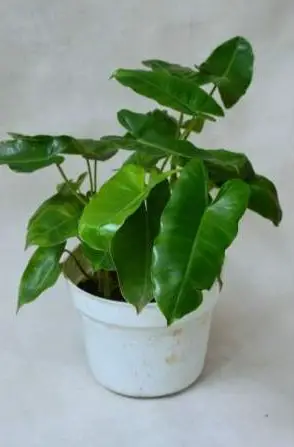
Philodendron Burle Marx thriving under any humidity conditions
Temperature Requirements
The ideal temperature range for Burle Marx Philodendron is between 65ºF (18ºC) to 75ºF (24ºC). Since Philodendron plants come from tropical regions, they don’t tolerate frost or very low temperatures.
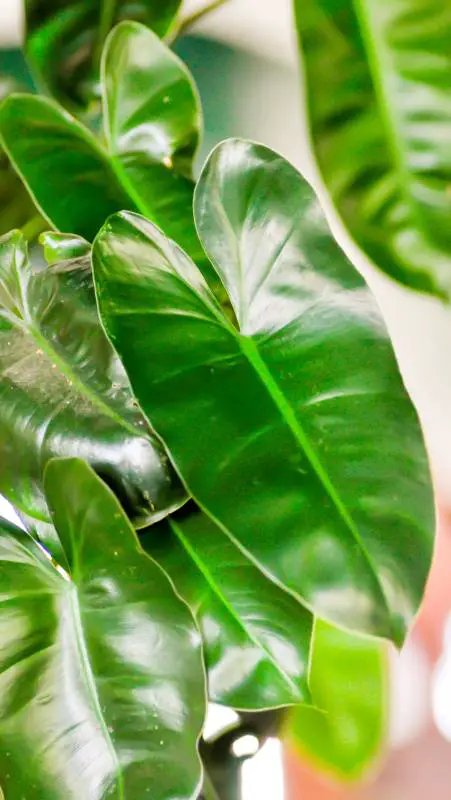
2-Philodendron burle-marxii2
Philodendron burle-marxii growing under the ideal temperature
Fertilizing
You don’t have to fertilize Burle Marx Philodendron if you repot it once a year. Repotting a Philodendron plant regularly provides it with fresh nutrients.
However, if you want to fertilize your Philodendron Burle Marx, go for the Sill fertilizer, which has an excellent N-P-K ratio of 9-3-6. Make sure to follow the dosage on the package. This goes for any fertilizer you may use.
Although you may come across the information that you should fertilize in spring or summer, this isn’t entirely true. If you decide to fertilize, you should do it when your Philodendron Burle Marx is actively growing. It doesn’t matter which part of the year it is, but whether your plant is actively growing or not.
If you fertilize during a period when your plant is not growing, all the nutrients will just be accumulating in the soil. This could lead to the burning of the roots, and you don’t want that.
Soil
The best soil for Philodendron Burle Marx is a well-draining, porous mix. Why is this so important? If the plant’s soil isn’t well-draining, it stays wet for a long time, increasing the chances of root rot.
That is why making your own potting soil mix is always a good option because you can add amendments like perlite, bark, gritty sand, pumice, vermiculite, etc. These amendments are important because they contain large particles. These large particles create macro pores, which contain oxygen. Macropores and oxygen decrease the chance of root rot. The risk of developing a bacterial or fungal infection causing root rot is higher without oxygen.
To make your own potting soil mix, use 2 parts of all-purpose soil, 1 part perlite, 1 part bark, or some other amendment like pumice, coarse sand, etc.
Repotting
Here are the steps to repotting Philodendron Burle Marx:
- Make a potting mix: 2 parts all-purpose soil, 1 part perlite, 1 part bark, or some other amendment like pumice, sand, etc
- Take one size bigger pot than the current one.
- Pull the soil away from the pot edges with a spatula or root rake, to be able to take the plant out.
- Take the plant out of the pot and slightly loosen the rootball.
- Inspect the roots. If you spot any diseased/soft/smelly/mushy roots, prune them.
- Fill ⅓ of the new pot with soil, put the plant in, and fill the remaining space with soil.
- Firmly press the soil around the plant and water it.
- Put it in front of a window with a minimum of medium indirect light
Repotting Philodendron Burle Marx isn’t complex. In general, you should repot your philodendron plant:
- To provide it with fresh nutrients
- Remove old compacted soil and provide non-compacted soil full of oxygen
- Enhance its growth once the current plant pot becomes too small.
Another useful tip is always to choose pots with drainage holes because they prevent the accumulation of excess water and help to drain out exces salts.
Terracotta pots are a great choice because they help the soil dry out faster by absorbing water from it, reducing the chances of root rot.
Toxicity To Humans
Philodendron Burle Marx is toxic to humans. California Poison Control System (CPCS) confirms that the sap of this plant has calcium oxalate crystals that can irritate lips, mouth, and tongue and sometimes cause problems with breathing that result in swelling in the throat.
Ann King Filmer, Ph.D. Plant Scientist from the University of California, in the publication “Safe and Poisonous Garden Plants” from October 2012, states that Philodendron Burle Marx can also cause a skin rash or irritation and stomach upset.
Toxicity To Pets
Philodendron Burle Marx is toxic to pets. According to the American Society For The Prevention Of Cruelty To Animals pets can experience mouth irritation and swelling of the mouth, tongue and lips. Some other signs include excessive drooling, vomiting, and difficulty swallowing.
Pruning
Pruning your Burle Marx Plant isn’t necessary. You don’t need to prune if your plant has healthy green leaves and stems. If you see leaves that are brown, dry, dead, or if your Philodendron Burle is diseased or heavily infested with pests, you should prune them off.
Sometimes people prune plants purely for aesthetic reasons. You can prune healthy stems if you want the plant to branch out below the cut. In that case, you can cut off the top of a stem. As a result, your plant will be bushier.
Propagation
You can propagate Philodendron Burle Marx in a few ways:
- Stem cuttings/tip cuttings
- Division
- Air layering
The easiest way to propagate Philodendron Burle Marx is by stem cuttings:
- Make sure your stem is long enough before cutting
- Don’t forget to sterilize your pruning shears prior to cutting.
- You want your cutting to have at least 2 nodes (node is the part of the stem from which leaves grow), so cut a stem below the second node from the top.
- Once you cut the stem, put it in water. Make sure both nodes are always submerged
- In order to increase the chance of successful propagation, provide an air pump for oxygen, and a heat mat for warmth. Increasing the water temperature and amount of oxygen will speed up propagation. Exposure to more light will also boost growth.
- You will see the new roots after about two weeks. Then it’s time to pot your new plants.
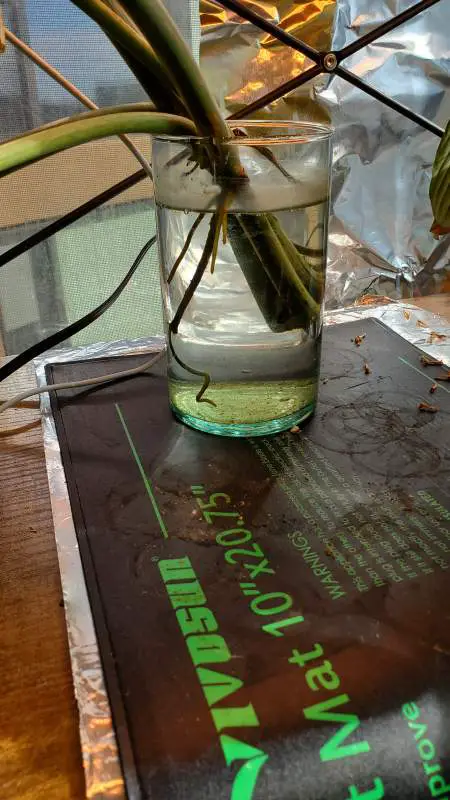
A heat mat to provide extra warmth for stem cuttings
Another way of propagating Philodendron Burle Marx is air layering. This method is great, especially if you are a beginner parent because there is no risk to your plant.
Follow these steps if you want to try air layering:
- Take some sphagnum moss and moisten it
- Squeeze it to remove excess water
- Wrap the sphagnum moss tightly around a node of the mother plant and cover it with plastic. A node is part of the stem where leaves come out.
- Make sure the moss is fully enclosed in the plastic so it doesn’t dry out (it needs to stay moist in order to grow roots)
- If you notice the moss drying out, unwrap, mist, and wrap it back up
- Wait 1 or 2 months
- After that time, you should notice roots growing throughout the moss. As soon as you have roots several inches long, it’s ok to take a cut. But to make things easier, you should wait until you see a large rootball inside the plastic. A larger root mass will help the cutting absorb water better once you cut it and pot it in soil
- You should use sterilized pruning shears when you actually make the cut to reduce the chances of infection
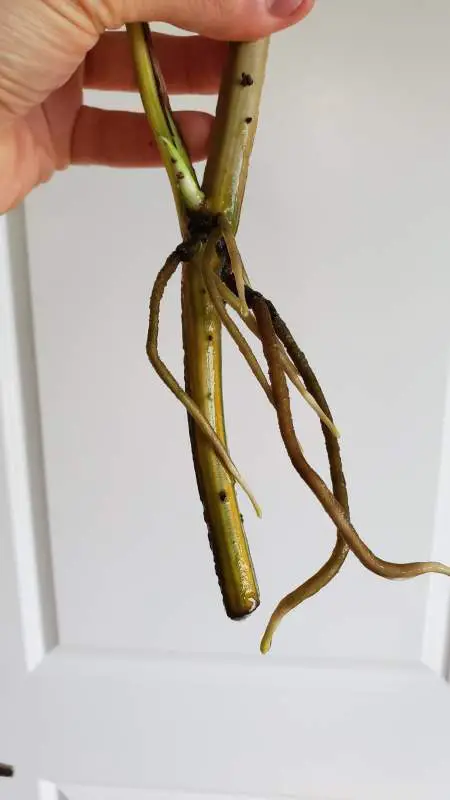
Propagated Philodendron Burle Marx
Air layering is a great propagation method because even if the roots never grow, you can just remove the moss and continue growing your plant in the pot. No harm done.
FAQs about Philodendron Burle Marx
Why are there sticky spots on my Philodendron Burle Marx?
The sticky spots on your Philodendron Burle Marx are, in most cases, produced by the plant. If they are accompanied by red spots, they are nothing to worry about. Red spots are called nectaries and are beneficial because the sticky drops they produce attract ants, and ants feed on plant pests. Some ants can also farm aphids, so if you see ants, check your plant to make sure there aren’t any aphids.
In some cases, plant pests can produce sticky spots. To make sure this is not the case, thoroughly inspect all leaves topside and underside for pests.
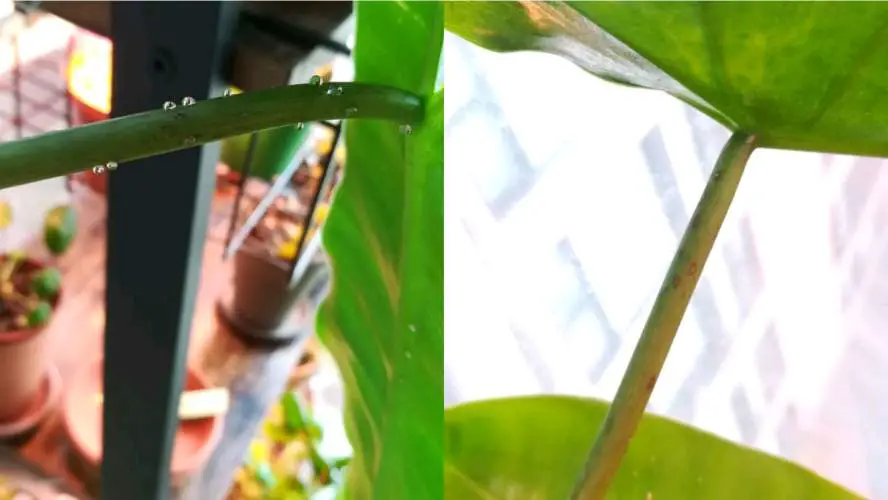
Sticky spots and nectaries on Philodendron Burle Marx
Check the video below for more details on nectaries:
Are There any Ways to Prevent Pests from Infesting my Philodendron Burle Marx?
There are a few ways to prevent pests from infesting your Philodendron Burle Marx. You can do that by:
- providing your plant with sufficient light
- making sure to water it properly
- repotting once a year to provide fresh, non-compacted soil with new nutrients
If a plant is healthy and is in a proper environment, getting proper care, it will be more resistant to pests and diseases. Although Burle Marx isn’t prone to pests, there are a few pests that can occur. The most common ones are mealybugs and thrips. Both suck the sap from your plant.
So what can you do to deter these little critters? Fortunately, there are natural methods to get rid of the pests:
- Spray the plant thoroughly with water under high pressure. This method is perfect for spider mites and plants with big leaves.
- Shower the plant if it has small leaves.
- Spray the plant with insecticidal soap or horticultural oil
- Buy beneficial insects like ladybugs or lacewings
For more details about each of these methods, check the video below:
Why is My Philodendron Burle Marx Losing Leaves?
There could be many reasons why your Philodendron Burle Marx is losing leaves: due to normal leaf loss (senescence), overwatering, underwatering, lack of light, pests, diseases, etc. Overwatering is one of the main culprits for a Philodendron Burle Marx plant losing leaves.
If you overwater your Burle Marx, the excess water prevents oxygen from getting to your plant’s roots. Less oxygen, higher the chance of root rot. Once the roots have rotted, the plant doesn’t have anything to absorb moisture with.
You shouldn’t immediately jump to conclusions and attribute certain diseases or diagnoses to your Phildonedron Burle.
Occasional losing leaves is normal, it is a part of a plant’s lifecycle. As plants grow, most will lose older leaves as they grow new ones.
More Questions on Philodendron Burle Marx?
If you have more questions on Philodendron Burle Marx or any other houseplant, let’s talk.
Always happy to help!
Yours Truly,
Yours Truly,

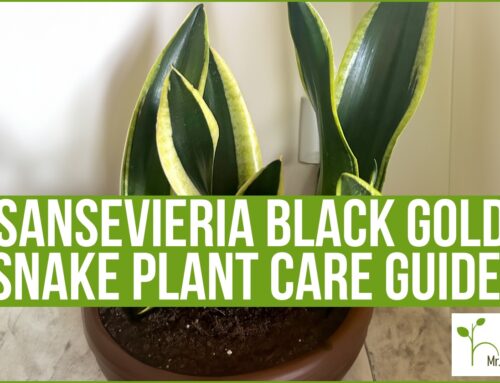




Under “Temperature requirements” there’s a picture of a Billietiae, not Burle Marx
Thank you so much for letting me know :) Mistakes happen. I replaced the photo
Ants will eat some pest just not the ones that are likely to harm your plant, termites, flies, etc. They will however bring aphids in to farm them for their honeydew. Ants will also build colonies in large pots and eventually kill the plant.
Thank you Joyce, yes, some ants can farm aphids, so it’s definitely something to look out for :) I added this to the text, so thank you, I appreciate it :) From what I know, ants won’t directly harm plants. But creating tunnels through the soil, especially under very small plants, which are easier to be disturbed could kill them. With Burle Marx that has an extensive root system, that doesn’t seem very likely to happen though.
I have a tall burle marx with 4 supports but they are all leaning and im afraid it will topple. Would you recomend going in a deeper pot?
Hi Charlie, I would recommend either tying the plant to a ceiling hook or pruning the top (since they are fast growers anyway). You can also repot into a larger/wider/heavier pot to make it more stable.